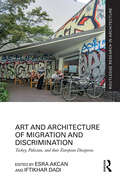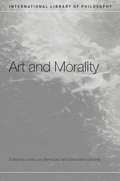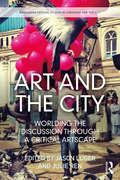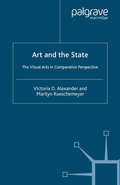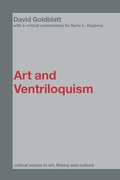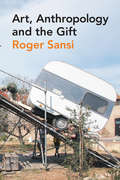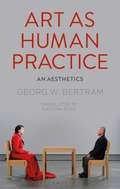- Table View
- List View
Art and Architecture of Migration and Discrimination: Turkey, Pakistan, and their European Diasporas (Routledge Research in Architecture)
This book brings together essays by established and emerging scholars that discuss Pakistan, Turkey, and their diasporas in Europe. Together, the contributions show the scope of diverse artistic media, including architecture, painting, postcards, film, music, and literature, that has responded to the partitions of the twentieth century and the Muslim diasporas in Europe. Turkey and Pakistan have been subject to two of the largest compulsory population transfers of the twentieth century. They have also been the sites for large magnitudes of emigration during the second half of the twentieth century, creating influential diasporas in European cities such as London and Berlin. Discrimination has been both the cause and result of migration: while internal problems compelled citizens to emigrate from their countries, blatant discriminatory and ideological constructs shaped their experiences in their countries of arrival. Read together, the Partition emerges from the essays in Part I not as a pathology specific to the Balkans, Middle East, or South Asia, but as a central problematic of the new political realities of decolonization and nation formation. The essays in Part II demonstrate the layered histories and multiple migration paths that have shaped the experiences of Berliners and Londoners. This analysis furthers the study of modernism and migration across the borders of, not only the nation-state, but also class, race, and gender. As a result, this book will be of interest to a broad multidisciplinary academic audience including students and faculty, artists, architects and planners, as well as non-specialist general public interested in visual arts, architecture and urban literature.
Art and Crime: Exploring the Dark Side of the Art World (Non-ser.)
by John StubbsThrough the use of case examples and careful examination, this book presents the first interdisciplinary essay collection on the study of art crime, and its effect on all aspects of the art world. Contributors discuss art crime subcategories, including vandalism, iconoclasm, forgery, fraud, peace-time theft, war looting, archaeological looting, smuggling, submarine looting, and ransom. The contributors offer insightful analyses coupled with specific practical suggestions to implement in the future to prevent and address art crime. This work is of critical importance to anyone involved in the art world, its trade, study, and security.Art crime has received relatively little attention from those who study art to those who prosecute crimes. Indeed, the general public is not well-aware of the various forms of art crime and its impact on society at large, to say nothing of museums, history, and cultural affairs. And yet it involves a multi-billion dollar legitimate industry, with a conservatively-estimated $6 billion annual criminal profit. Information about and analysis of art crime is critical to the wide variety of fields involved in the art trade and art preservation, from museums to academia, from auction houses to galleries, from insurance to art law, from policing to security. Since the Second World War, art crime has evolved from a relatively innocuous crime, into the third highest-grossing annual criminal trade worldwide, run primarily by organized crime syndicates, and therefore funding their other enterprises, from the drug and arms trades to terrorism. It is no longer merely the art that is at stake.
Art and Culture in the Multiverse of Metaverses: Immersion, Presence, and Interactivity in the Digital Age (Springer Series on Cultural Computing)
by James HutsonDrawing on the art historical framing of Location, Place, and Identity, this book will examine how the factors of Immersion, Presence, and Interactivity of XR are shaping our understanding of the world and our place within it. Location refers to the specific geographical or spatial context in which a work of art is created or experienced. Place refers to the social, cultural, and historical context of that location. Identity refers to the ways in which individuals and communities construct and express their sense of self and belonging within those contexts. Through case studies and theoretical analysis, Art and Culture in the Multiverse of Metaverses - Immersion, Presence, and Interactivity in the Digital Age, will explore how the factors of Immersion, Presence, and Interactivity of XR can be aligned with these art historical concepts, providing new opportunities for understanding and engaging with Location, Place, and Identity. For example, XR can be used to create immersive experiences of historical locations and cultural sites, allowing users to explore and engage with them in ways that would otherwise be impossible. Additionally, XR can be used to create interactive artworks that engage with issues of identity and belonging, creating new possibilities for self-expression and exploration.
Art and Experience (Studies in Art, Culture, and Communities)
by Ananta C. SuklaIn recent years, experience has been one of the most ambiguous, evasive, and controversial terms in myriad disciplines including epistemology, religion, literary theory, and philosophical aesthetics. Its association with the subjective consciousness has deprived it of the cognitive status of human knowledge. ^IArt and Experience^R aims to grasp a firmer hold on this elusive concept, via essays written by a distinguished group of international scholars who have rediscovered the foundation of experience and restored its cognitive status in understanding our cultural activities. Indeed, emotions and experience play a vital role in human cognition, and the symbiotic relationship between culture and experience is a subject long overdue for further study.Clarifying the intricacies scholars face in understanding the concept of experience, this volume's broad approach makes it an invaluable contribution to the study of the humanities. Its uniqueness lies in its focusing on the manifold aspects of the concept rather than in drawing any singular, dogmatic conclusion about its nature and function.
Art and Life in Modernist Prague: Karel Čapek and his Generation, 1911-1938 (Palgrave Studies in Cultural and Intellectual History)
by T. OrtIn most contemporary historical writing the picture of modern life in Habsburg Central Europe is a gloomy story of the failure of rationalism and the rise of protofascist movements. This book tells a different story, focusing on the Czech writers and artists distinguished by their optimistic view of the world in the years before WWI.
Art and migration: Revisioning the borders of community (Rethinking Art's Histories)
by Amelia JonesThis collection offers a response to the view that migration disrupts national heritage. Investigating the mediation provided by migrant art, it asks how we can rethink art history in a way that uproots its reliance on space and place as stable definitions of style. Beginning with an invaluable overview of migration studies terminology and concepts, Art and migration opens dialogues between academics of art history and migrations studies through a series of essays and interviews. It also re-evaluates the cultural understanding of borders and revisits the contours of the art world – a supposedly globalised community re-assessed here as structurally bordered by art market dynamics, career constraints, gatekeeping and patronage networks.
Art and migration: Revisioning the borders of community (Rethinking Art's Histories)
by Amelia JonesThis collection offers a response to the view that migration disrupts national heritage. Investigating the mediation provided by migrant art, it asks how we can rethink art history in a way that uproots its reliance on space and place as stable definitions of style. Beginning with an invaluable overview of migration studies terminology and concepts, Art and migration opens dialogues between academics of art history and migrations studies through a series of essays and interviews. It also re-evaluates the cultural understanding of borders and revisits the contours of the art world – a supposedly globalised community re-assessed here as structurally bordered by art market dynamics, career constraints, gatekeeping and patronage networks.
Art and Morality
by José Luis Bermúdez Sebastian GardnerFeaturing contributions from Matthew Kieran, Aaron Ridley, Roger Scruton and Mary Mothersill to name but a few, this collection of groundbreaking new papers on aesthetics and ethics, highlights the link between the two subjects. These leading figures tackle the important questions that arise when one thinks about the moral dimensions of art and the aesthetic dimension of moral life.The volume is a significant contribution to philosophical literature, opening up unexplored questions and shedding new light on more traditional debates in aesthetics. The topics explored include:the relation of aesthetic to ethical judgment the relation of artistic experience to moral consciousnessthe moral status of fictionthe concepts of sentimentality and decadencethe moral dimension of critical practice, pictorial art and musicthe moral significance of tragedythe connections between artistic and moral issues elaborated in the writings of central figures in modern philosophy, such as Kant, Schopenhauer and Nietzsche.The contributors share the view that progress in aesthetics requires detailed study of the practice of criticism. This volume will appeal to both the philosophical community and to researchers in areas such as literary theory, musicology and the theory of art.
Art and Morality (International Library Of Philosophy Ser.)
by Sebastian GardnerFeaturing contributions from Matthew Kieran, Aaron Ridley, Roger Scruton and Mary Mothersill to name but a few, this collection of groundbreaking new papers on aesthetics and ethics, highlights the link between the two subjects. These leading figures tackle the important questions that arise when one thinks about the moral dimensions of art and the aesthetic dimension of moral life.The volume is a significant contribution to philosophical literature, opening up unexplored questions and shedding new light on more traditional debates in aesthetics. The topics explored include:the relation of aesthetic to ethical judgment the relation of artistic experience to moral consciousnessthe moral status of fictionthe concepts of sentimentality and decadencethe moral dimension of critical practice, pictorial art and musicthe moral significance of tragedythe connections between artistic and moral issues elaborated in the writings of central figures in modern philosophy, such as Kant, Schopenhauer and Nietzsche.The contributors share the view that progress in aesthetics requires detailed study of the practice of criticism. This volume will appeal to both the philosophical community and to researchers in areas such as literary theory, musicology and the theory of art.
Art and Protest in Putin's Russia (Routledge Contemporary Russia and Eastern Europe Series)
by Lena JonsonThe Pussy Riot protest, and the subsequent heavy handed treatment of the protestors, grabbed the headlines, but this was not an isolated instance of art being noticeably critical of the regime. As this book, based on extensive original research, shows, there has been gradually emerging over recent decades a significant counter-culture in the art world which satirises and ridicules the regime and the values it represents, at the same time putting forward, through art, alternative values. The book traces the development of art and protest in recent decades, discusses how art of this kind engages in political and social protest, and provides many illustrations as examples of art as protest. The book concludes by discussing how important art has been in facilitating new social values and in prompting political protests.
Art and Protest in Putin's Russia (Routledge Contemporary Russia and Eastern Europe Series)
by Lena JonsonThe Pussy Riot protest, and the subsequent heavy handed treatment of the protestors, grabbed the headlines, but this was not an isolated instance of art being noticeably critical of the regime. As this book, based on extensive original research, shows, there has been gradually emerging over recent decades a significant counter-culture in the art world which satirises and ridicules the regime and the values it represents, at the same time putting forward, through art, alternative values. The book traces the development of art and protest in recent decades, discusses how art of this kind engages in political and social protest, and provides many illustrations as examples of art as protest. The book concludes by discussing how important art has been in facilitating new social values and in prompting political protests.
Art and Representation: Contributions to Contemporary Aesthetics
by Ananta C. SuklaConcentrating on scholarship over the past four decades, this multidisciplinary approach to representation considers conceptual issues about representation and applies different theories to various arts. Following an introduction that traces the historical debates surrounding the concept of representation, Part One focuses on representation and language, epistemology, politics and history, sacrificial rites, possible world and postmodernism. Part Two applies current theories to painting, photography, literature, music, dance, and film. Writings highlight the vital role representation plays in the formation and appreciation of major genres of art.This work will appeal to art philosophy and aesthetics scholars and to cultural studies and linguistic scholars. Rather than advocate certain theories, the essays illustrate the inherent complexities of representation.
The Art and Science of Connection: Why Social Health is the Missing Key to Living Longer, Healthier, and Happier
by Kasley KillamA groundbreaking redefinition of what it means to be healthy that introduces the need for social health - the part of wellbeing that comes from feeling connected - to truly flourish.Exercise. Eat a balanced diet. Go to therapy. Most wellness advice is focused on achieving and maintaining good physical and mental health. But Harvard-trained social scientist and pioneering social health expert Kasley Killam reveals that this approach is missing a vital component: human connection.Relationships not only make us happier, but also are critical to our overall health and longevity. Research shows that people with a strong sense of belonging are 2.6 times more likely to report good or excellent health. Perhaps even more astonishingly, people who lack social support are up to 53% more likely to die from any cause. Yet social health has been overlooked and underappreciated - until now.Just as we exercise our physical muscles, we can strengthen our social muscles. Weaving together cutting-edge science, mindset shifts, and practical wisdom, Killam offers the first methodology for how to be socially healthy. An antidote to the loneliness epidemic and an inspiring manifesto for seeing wellbeing as not only physical and mental, but also social, The Art and Science of Connection is a handbook for thriving.In this essential book, you will:- Learn a simple yet powerful framework to understand, evaluate, and bolster your social health.- Discover the exact strategy or habit you need, as well as research-backed tips, to cultivate and sustain meaningful connection now and throughout your life.- Glean actionable insights to develop a sense of community in your neighbourhood, at work, and online from a spirited group of neighbours in Paris, the CEO of a major healthcare company, and an artificially intelligent chatbot.- Get an insider look at the innovative ways that doctors, teachers, entrepreneurs, architects, government leaders, and everyday people are catalysing a movement toward a more socially healthy society.The Art and Science of Connection will transform the way you think about each interaction with a friend, family member, coworker, or neighbour, and give you the tools you need to live a more connected and healthy life - whether you are an introvert or extrovert, if you feel stretched thin, and no matter your age or background. Along the way, Killam will reveal how a university student, a newlywed, a working professional, and a retired widow overcame challenges to thrive through connection-and how you can, too.
The Art and Science of Embodied Research Design: Concepts, Methods and Cases
by Edited by Jennifer Frank TantiaThe Art and Science of Embodied Research Design: Concepts, Methods, and Cases offers some of the nascent perspectives that situate embodiment as a necessary element in human research. This edited volume brings together philosophical foundations of embodiment research with application of embodied methods from several disciplines. The book is divided into two sections. Part I, Concepts in Embodied Research Design, suggests ways that embodied epistemology may bring deeper understanding to current research theory, and describes the ways in which embodiment is an integral part of the research process. In Part II, Methods and Cases, chapters propose novel ways to operationalize embodied data in the research process. The section is divided into four sub-sections: Somatic Systems of Analysis, Movement Systems of Analysis, Embodied Interviews and Observations, and Creative and Mixed Methods. Each chapter proposes a method case; an example of a previously used research method that exemplifies the way in which embodiment is used in a study. As such, it can be used as scaffold for designing embodied methods that suits the researcher’s needs. It is suited for many fields of study such as psychology, sociology, behavioral science, anthropology, education, and arts-based research. It will be useful for graduate coursework in somatic studies or as a supplemental text for courses in traditional research design.
The Art and Science of Embodied Research Design: Concepts, Methods and Cases
by Jennifer Frank TantiaThe Art and Science of Embodied Research Design: Concepts, Methods, and Cases offers some of the nascent perspectives that situate embodiment as a necessary element in human research. This edited volume brings together philosophical foundations of embodiment research with application of embodied methods from several disciplines. The book is divided into two sections. Part I, Concepts in Embodied Research Design, suggests ways that embodied epistemology may bring deeper understanding to current research theory, and describes the ways in which embodiment is an integral part of the research process. In Part II, Methods and Cases, chapters propose novel ways to operationalize embodied data in the research process. The section is divided into four sub-sections: Somatic Systems of Analysis, Movement Systems of Analysis, Embodied Interviews and Observations, and Creative and Mixed Methods. Each chapter proposes a method case; an example of a previously used research method that exemplifies the way in which embodiment is used in a study. As such, it can be used as scaffold for designing embodied methods that suits the researcher’s needs. It is suited for many fields of study such as psychology, sociology, behavioral science, anthropology, education, and arts-based research. It will be useful for graduate coursework in somatic studies or as a supplemental text for courses in traditional research design.
Art and the City: Worlding the Discussion through a Critical Artscape (Routledge Critical Studies in Urbanism and the City)
by Jason Luger Julie RenArtistic practices have long been disturbing the relationships between art and space. They have challenged the boundaries of performer/spectator, of public/private, introduced intervention and installation, ephemerality and performance, and constantly sought out new modes of distressing expectations about what is construed as art. But when we expand the world in which we look at art, how does this change our understanding of critical artistic practice? This book presents a global perspective on the relationship between art and the city. International and leading scholars and artists themselves present critical theory and practice of contemporary art as a politicised force. It extends thinking on contemporary arts practices in the urban and political context of protest and social resilience and offers the prism of a ‘critical artscape’ in which to view the urgent interaction of arts and the urban politic. The global appeal of the book is established through the general topic as well as the specific chapters, which are geographically, socially, politically and professionally varied. Contributing authors come from many different institutional and anti-institutional perspectives from across the world. This will be valuable reading for those interested in cultural geography, urban geography and urban culture, as well as contemporary art theorists, practitioners and policymakers.
Art and the City: Worlding the Discussion through a Critical Artscape (Routledge Critical Studies in Urbanism and the City)
by Jason Luger Julie RenArtistic practices have long been disturbing the relationships between art and space. They have challenged the boundaries of performer/spectator, of public/private, introduced intervention and installation, ephemerality and performance, and constantly sought out new modes of distressing expectations about what is construed as art. But when we expand the world in which we look at art, how does this change our understanding of critical artistic practice? This book presents a global perspective on the relationship between art and the city. International and leading scholars and artists themselves present critical theory and practice of contemporary art as a politicised force. It extends thinking on contemporary arts practices in the urban and political context of protest and social resilience and offers the prism of a ‘critical artscape’ in which to view the urgent interaction of arts and the urban politic. The global appeal of the book is established through the general topic as well as the specific chapters, which are geographically, socially, politically and professionally varied. Contributing authors come from many different institutional and anti-institutional perspectives from across the world. This will be valuable reading for those interested in cultural geography, urban geography and urban culture, as well as contemporary art theorists, practitioners and policymakers.
Art and the State: The Visual Arts in Comparative Perspective (St Antony's Series)
by V. Alexander M. RueschemeyerThis book examines the impact of states and their policies on visual art. States shape the role of art and artists in society, influence the development of audiences, support artistic work, and even affect the very nature of artistic production. The book contrasts developments in the United States with art policies in Britain and in the social democratic states of Norway and Sweden. In addition, it analyzes revealing transitions - the changes brought about in East Germany after unification and the experiences of artists who left the Soviet Union for the west. The result is a significant contribution to the sociology and the political economy of art.
Art and Ventriloquism (Critical Voices in Art, Theory and Culture)
by David GoldblattThis exciting collection of David Goldblatt's essays, available for the first time in one volume, uses the metaphor of ventriloquism to help understand a variety of art world phenomena. It examines how the vocal vacillation between ventriloquist and dummy works within the roles of artist, artwork and audience as a conveyance to the audience of the performer's intentions, emotions and beliefs through a created performative persona. Considering key works, including those of Nietzsche, Foucault, Socrates, Derrida, Cavell and Wittgenstein, Goldblatt examines how the authors use the framework of ventriloquism to construct and negate issues in art and architecture. He ponders 'self-plagiarism'; why the classic philosopher cannot speak for himself, but must voice his thoughts through fictional characters or inanimate objects and works. With a close analysis of two ventriloquist paintings by Jasper Johns and Paul Klee, a critical commentary by Garry L. Hagberg, and preface by series editor Saul Ostrow, Goldblatt's thoroughly fascinating book will be an invaluable asset to students of cultural studies, art, and philosophy.
Art and Ventriloquism (Critical Voices in Art, Theory and Culture)
by David GoldblattThis exciting collection of David Goldblatt's essays, available for the first time in one volume, uses the metaphor of ventriloquism to help understand a variety of art world phenomena. It examines how the vocal vacillation between ventriloquist and dummy works within the roles of artist, artwork and audience as a conveyance to the audience of the performer's intentions, emotions and beliefs through a created performative persona. Considering key works, including those of Nietzsche, Foucault, Socrates, Derrida, Cavell and Wittgenstein, Goldblatt examines how the authors use the framework of ventriloquism to construct and negate issues in art and architecture. He ponders 'self-plagiarism'; why the classic philosopher cannot speak for himself, but must voice his thoughts through fictional characters or inanimate objects and works. With a close analysis of two ventriloquist paintings by Jasper Johns and Paul Klee, a critical commentary by Garry L. Hagberg, and preface by series editor Saul Ostrow, Goldblatt's thoroughly fascinating book will be an invaluable asset to students of cultural studies, art, and philosophy.
Art, Anthropology, and Contested Heritage: Ethnographies of TRACES
by Arnd SchneiderThis book presents innovative ethnographic perspectives on the intersections between art, anthropology, and contested cultural heritage, drawing on research from the interdisciplinary TRACES project (funded by the EU's Horizon 2020 program). The case studies in this volume critically assess how and in which arrangements artistic/aesthetic methods and creative everyday practices contribute to strengthening communities both culturally and economically. They also explore the extent to which these methods emphasize minority voices and ultimately set in motion a process of reflexive Europeanisation from below which unfolds within Europe and beyond its borders. At the heart of the book is the development of a new way of transmitting contentious cultural heritage, which responds to the present situation in Europe of unstable political conditions and a sense of Europe in crisis. With chapters looking at difficult art exhibitions on colonialism, death masks, Holocaust memorials, and skull collections, the contributors articulate a response to the crisis in current economic-political conditions in Europe and advances brand new theoretical groundwork on the configuration of a renewed European identity.
Art, Anthropology, and Contested Heritage: Ethnographies of TRACES
This book presents innovative ethnographic perspectives on the intersections between art, anthropology, and contested cultural heritage, drawing on research from the interdisciplinary TRACES project (funded by the EU's Horizon 2020 program). The case studies in this volume critically assess how and in which arrangements artistic/aesthetic methods and creative everyday practices contribute to strengthening communities both culturally and economically. They also explore the extent to which these methods emphasize minority voices and ultimately set in motion a process of reflexive Europeanisation from below which unfolds within Europe and beyond its borders. At the heart of the book is the development of a new way of transmitting contentious cultural heritage, which responds to the present situation in Europe of unstable political conditions and a sense of Europe in crisis. With chapters looking at difficult art exhibitions on colonialism, death masks, Holocaust memorials, and skull collections, the contributors articulate a response to the crisis in current economic-political conditions in Europe and advances brand new theoretical groundwork on the configuration of a renewed European identity.
Art, Anthropology and the Gift
by Roger SansiIn recent decades, the dialogue between art and anthropology has been both intense and controversial. Art, Anthropology and the Gift provides a much-needed and comprehensive overview of this dialogue, whilst also exploring the reciprocal nature of the two subjects through practice, theory and politics. Fully engaging with anthropology and art theory, this book innovatively argues that art and anthropology don’t just share methodologies, but also deeper intellectual, theoretical and even political concerns, inviting scholars and students alike to look at this contentious relationship in a more critical light. One of the central arguments of the book is that the problem of the ‘gift’ has been central to both anthropological and artistic practice. This very idea connects the different chapters on topics including aesthetics, politics, participation and fieldwork.
Art, Anthropology and the Gift (Criminal Practice Ser.)
by Roger SansiIn recent decades, the dialogue between art and anthropology has been both intense and controversial. Art, Anthropology and the Gift provides a much-needed and comprehensive overview of this dialogue, whilst also exploring the reciprocal nature of the two subjects through practice, theory and politics. Fully engaging with anthropology and art theory, this book innovatively argues that art and anthropology don’t just share methodologies, but also deeper intellectual, theoretical and even political concerns, inviting scholars and students alike to look at this contentious relationship in a more critical light. One of the central arguments of the book is that the problem of the ‘gift’ has been central to both anthropological and artistic practice. This very idea connects the different chapters on topics including aesthetics, politics, participation and fieldwork.
Art as Human Practice: An Aesthetics
by Georg W. BertramHow is art both distinct and different from the rest of human life, while also mattering in and for it? This central yet overlooked question in contemporary philosophy of art is at the heart of Georg Bertram's new aesthetic. Drawing on the resources of diverse philosophical traditions – analytic philosophy, French philosophy, and German post-Kantian philosophy – his book offers a systematic account of art as a human practice. One that remains connected to the whole of life.
